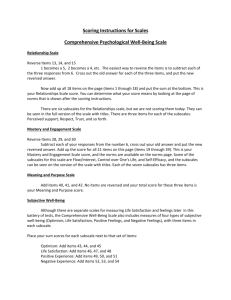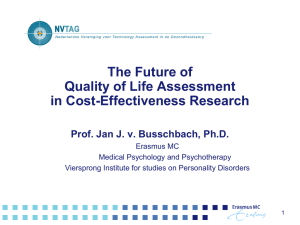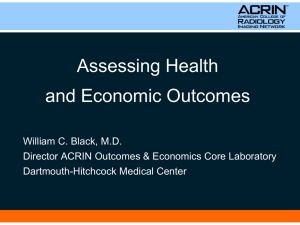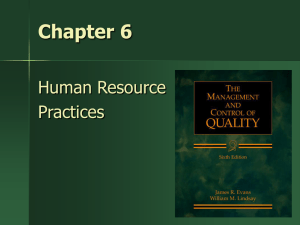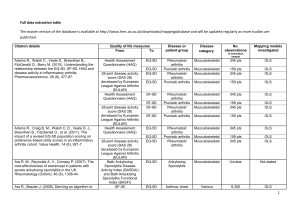Well-being measures - University of Sheffield
advertisement
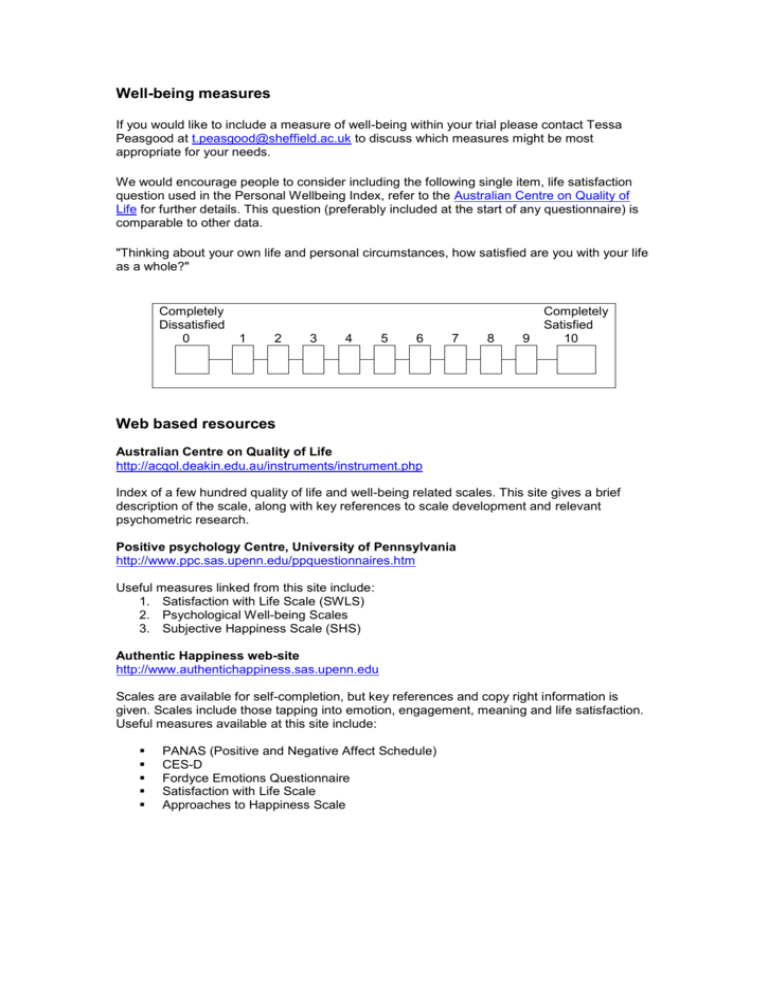
Well-being measures If you would like to include a measure of well-being within your trial please contact Tessa Peasgood at t.peasgood@sheffield.ac.uk to discuss which measures might be most appropriate for your needs. We would encourage people to consider including the following single item, life satisfaction question used in the Personal Wellbeing Index, refer to the Australian Centre on Quality of Life for further details. This question (preferably included at the start of any questionnaire) is comparable to other data. "Thinking about your own life and personal circumstances, how satisfied are you with your life as a whole?" Completely Dissatisfied 0 1 2 3 4 5 6 7 8 9 Completely Satisfied 10 Web based resources Australian Centre on Quality of Life http://acqol.deakin.edu.au/instruments/instrument.php Index of a few hundred quality of life and well-being related scales. This site gives a brief description of the scale, along with key references to scale development and relevant psychometric research. Positive psychology Centre, University of Pennsylvania http://www.ppc.sas.upenn.edu/ppquestionnaires.htm Useful measures linked from this site include: 1. Satisfaction with Life Scale (SWLS) 2. Psychological Well-being Scales 3. Subjective Happiness Scale (SHS) Authentic Happiness web-site http://www.authentichappiness.sas.upenn.edu Scales are available for self-completion, but key references and copy right information is given. Scales include those tapping into emotion, engagement, meaning and life satisfaction. Useful measures available at this site include: PANAS (Positive and Negative Affect Schedule) CES-D Fordyce Emotions Questionnaire Satisfaction with Life Scale Approaches to Happiness Scale Some widely used/recent measures Mental health Positive mental health Warwick-Edinburgh Mental Well-being Scale (WEMWBS) o http://www.healthscotland.com/documents/1467.aspx o still under development and psychometric testing o currently 14 positively worded items, each with 5 response categories o covers most aspects of positive mental health (positive thoughts and feelings) currently in the literature, including both hedonic and eudaimonic perspectives Mental health scales, used within SWB literature GHQ-12 o http://www.webpoll.org/psych/GHQ12.htm o originally consisting of 60 questions about mild somatic and psychological symptoms, later condensed to 30- and 12-item questionnaires Patient Health Questionnaire (PHQ-9) Quick Depression scale o http://www.patient.co.uk/showdoc/40025272/ Center for Epidemiologic Studies Depression Scale (CES-D) o http://www.chcr.brown.edu/pcoc/cesdscale.pdf o 20-item scale, 4 response options based on frequency of experiencing specified emotional states during the last week o scored from 0 to 60 Measures of affect PANAS (Positive and Negative Affect Schedule) o 10 positive affects (interested, excited, strong, enthusiastic, proud, alert, inspired, determined, attentive, and active) and 10 negative affects (distressed, upset, guilty, scared, hostile, irritable, ashamed, nervous, jittery, and afraid) o participants are asked to rate items on a scale from 1 to 5 o summed scores for each scale 6-30 Bradburn’s Affect Balance scale o 10-item rating scale containing five statements reflecting positive feelings and five statements reflecting negative feelings o Respondents are asked by an interviewer to focus on feelings during the past few weeks and indicate a positive (yes) or negative (no) response to each of the scale items o Positive affect is obtained by summing the 5 positive questions (scale of 0 to 5) and negative affect by summing the negative questions. Affect Balance Scale is scored by subtracting the negative from the positive and adding a constant of 5 to avoid negative values Experience Sampling Method (ESM) o http://www.ncbi.nlm.nih.gov/pubmed/3655778 o Subjects carry a beeper device that signals randomly. Each time the beeper activates, subjects fill out a survey that typically includes questions asking what the subject was doing, who they were with, and how the subject was feeling at the time of the alarm Day Reconstruction Method (Kahneman and Kreuger) o http://sitemaker.umich.edu/norbert.schwarz/files/drm_documentation_july_20 04.pdf o a hybrid approach in which respondents first revive memories of the previous day by constructing a diary consisting of a sequence of episodes. Then they describe each episode by answering questions about the situation and about the feelings that they experienced, as in experience sampling Life satisfaction Single item Wording can vary BHPS wording http://www.iser.essex.ac.uk/ulsc/bhps/doc/volb/wave15/oindresp16.p hp#OLFSATO Defra wording http://www.defra.gov.uk/news/2007/070727b.htm Multiple item o Satisfaction with Life Scale (SWLS) http://www.ppc.sas.upenn.edu/lifesatisfactionscale.pdf 5 item questionnaire, each with 7 response scales this scale has been extended to incorporate a time dimension by the Temporal Satisfaction With Life Scale (TSWLS) o Global Quality of Life Assessment Domain satisfactions and domain-weighted life satisfaction Australian Personal Well-Being Index (PWI) o http://acqol.deakin.edu.au/instruments/wellbeing_index.htm o includes a school and pre-school version Needs based, flourishing and multi-dimensional measures of well-being Basic Psychological Needs Scale (Deci & Ryan) o http://www.psych.rochester.edu/SDT/measures/needs_scl.html o Family of scales, one that addresses needs satisfaction in general in ones life, others than address needs satisfaction in specific domains (e.g. work, interpersonal) o Original scale had 21 items concerning needs for competence, autonomy and relatedness o Some studies work with only 9 items (3 for each dimension) Approaches to Happiness (OTH) Scale o http://www.authentichappiness.sas.upenn.edu o life of meaning (6 questions), life of pleasure (6 questions), life of engagement (6 questions) o each with the response scale: 1 "Very much unlike me" to 5 "Very much like me" o scoring for each dimension is the average of the 6 questions WHO-QOL (100 & BREF) o http://www.who.int/substance_abuse/research_tools/whoqolbref/en/ o WHO-QOL aimed to be an international cross-culturally comparable quality of life assessment instrument o WHOQOL-BREF instrument comprises 26 items, which measure the following domains: physical health, psychological health, social relationships, and environment o the average of each domain is taken, giving a profile of 4 separate domain scores Psychological Well-Being Scales (Ryff’s) o six dimensions: autonomy, positive relations with others, purpose in life, selfacceptance, environmental mastery and personal growth o the original scale had 20 items contained within each of the 6 dimensions. This has been reduced to 14 items per dimension, and more recently 3 items per dimension CASP-19 o http://www.ncbi.nlm.nih.gov/pubmed/12775399 o Quality of life index for older people, developed from a needs based perspective o 19 item Likert scaled index o questions on 4 domains: Control, Autonomy, Self-realisation and Pleasure o sum of all items (0 to 57) European Social Survey. Module on well-being http://www.cambridgewellbeing.org/Files/Well-being-Module_Jun06.pdf a wide range of questions on feelings and functionings Health-utility measures EQ-5D http://www.euroqol.org/ EQ-5D is a standardised instrument for use as a measure of health outcome The EQ-5D consists of 243 distinct health states across five dimensions (mobility, self-care, usual activities, pain/discomfort and anxiety/depression), each with three levels (no problem, moderate problem and severe problem) The EQ-5D is often administered with a Visual Analogue Scale (VAS) or ‘feeling thermometer’ requiring a direction valuation of the individual’s health on a scale from worst health imaginable to best imaginable Utility values for each state have been elicited from respondents using the EQ-5D VAS technique in 8 European countries, and the TTO method has been used to elicit values for 5 countries Denmark, Germany, Japan, Spain and the UK The scoring algorithm, or social tariff, for the UK is based on preferences of a random sample of non-institutionalised adults throughout the UK (Dolan, 1997), using the Time Trade Off (TTO) method. EuroQol values are anchored by ‘1’ representing full health and ‘0’ representing the state ‘dead’ with states ‘worse than death’ bounded by ‘-1’ SF-6D http://www.shef.ac.uk/scharr/sections/heds/mvh/sf-6d The SF-6D is a classification for describing health derived from a selection of SF-36 items The SF-6D is composed of six multi-level dimensions. Any patient who completes the SF-36 or the SF-12 can be uniquely classified according to the SF-6D The SF-6D describes 18,000 health states in total The SF-6D comes with a set of preference weights obtained from a sample of the general population using the recognised valuation technique of standard gamble. Members of the general population were asked to value a selection of health states from which a model has been estimated to predict all the health states described by the SF-6D QWB An interviewer-administered general health related quality of life questionnaire measuring symptoms, mobility, physical activity and social activity Scores can be translated into utility values for quality of adjusted life years. A set of values for the QWB were derived using a VAS approach (anchored at ‘0’ for death/worst possible and ‘100’ for optimum health) among a random sample of 435 English-speaking residents in San Diego, California (Sieber et al., 2004) http://www.outcomes-trust.org/instruments.htm#QWB HUI2 and HUI3 http://www.shef.ac.uk/scharr/sections/heds/mvh/hui2 http://www.healthutilities.com/hui3.htm The Health Utilities Index (HUI) has two versions, HUI2 and HUI3 (Feeny et al., 1995) HUI3 defines 24,000 health states using seven attributes (sensation, mobility, emotion, cognition, self-care, pain and fertility) with three to five levels per attribute HUI2 defines 960,000 health states using eight attributes (vision, hearing, speech, ambulation, dexterity, emotion, cognition and pain) with five to six levels per attribute Both the HUI2 and HUI3 can be administered with a 15 item questionnaire The HUI3 scoring function is based on preference measurements obtained from a small random sample of the general population in Hamilton, Ontario, Canada, using Standard Gamble (SG) estimated from transformed VAS UK valuation of the HUI2: http://www.shef.ac.uk/scharr/sections/heds/mvh/hui2


